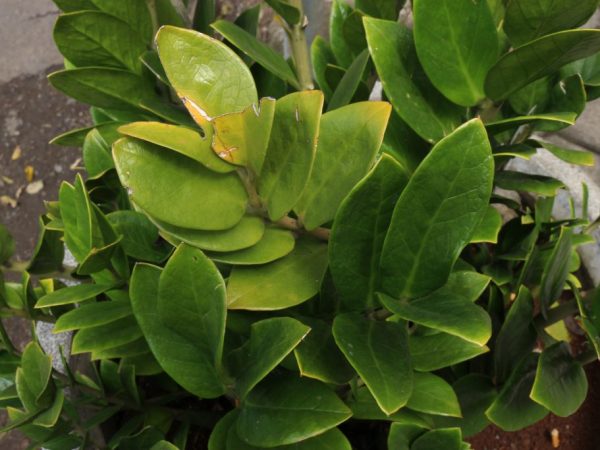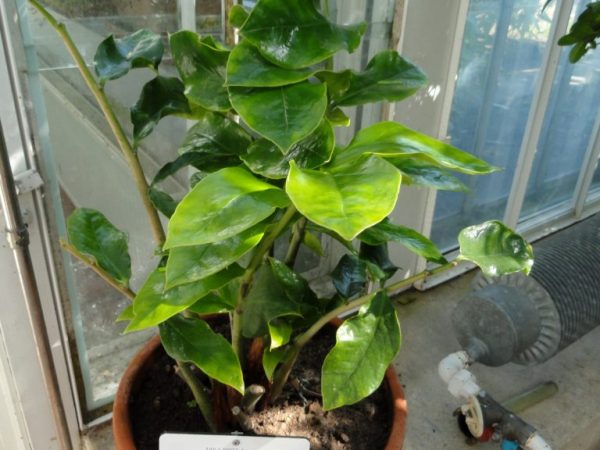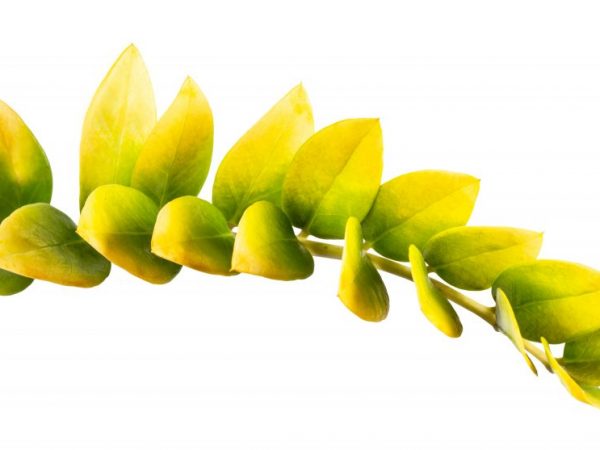Zamioculcas - causes of yellowing of leaves and ways to eliminate the problem
It is quite difficult to imagine any house without indoor flowers - they play an important aesthetic role in the decoration of both apartments and offices. However, even the most unpretentious plants can lose their decorative qualities and get sick. This is due to a greater extent to the difference in the created and natural conditions, as well as incorrect care. Z Zamioculcas, or dollar tree, is one of the representative and widely demanded crops. If his leaves turn yellow, you need to understand the reason for this process as soon as possible.

Zamioculcas - causes of yellowing of leaves and ways to eliminate the problem
Natural causes
Aging is an irreversible process during which old leaves die off and new leaves are formed.
Due to physiological characteristics, no more than 17 leaf lobes can be simultaneously located on adult shoots of zamiokulkas - later on, the vegetative processes are lengthened and the plates are replaced by productive ones.
If in a plant single lower segments acquire a yellow tint and the formation of a petiole is observed, you should not worry, these are obvious symptoms of renewal.
Care errors
Zamioculcas is a native of Africa, belongs to the Cactus family. It is believed that with its purchase, the owner receives stable material well-being as a bonus.
It is a strong tree or shrub, the aerial part of which is covered with rather large fleshy leaves of a rich green color.
It is not capricious, but like the bulk of indoor plants, it can be exposed to various diseases and attacks of insects. In order not to bring the situation to a critical point, one should carefully monitor the state and development of culture.
If the leaves of a flower turn yellow, the first thing to revise is the compliance of the care provided with the requirements of succulents.
Watering
The most common cause of yellow foliage is improper watering. Zamioculcas is extremely sensitive to a highly moistened substrate. The root system is a tuber, the function of which is to accumulate moisture and further supply it to the stems as needed.
With too much liquid, the process of decay of the underground part begins, as a result of which the leaf lobes turn yellow and fall off, brown watery spots appear on the surface.
Watering should be carried out only after the top layer of the soil has dried, while you must not forget to remove the water accumulated in the pan.
- In summer, on average, every 7-10 days.
- During the rest period, in winter, the frequency is reduced to once a month.
If in doubt about the event, it is better to wait 1-2 days, without fear that the tree will dry out - overflow is more destructive for it than a short-term drought.
Water is used exclusively at room temperature, previously settled for at least 12 hours.
Wrong location
Zamioculcas, like any native of Africa, prefers well-lit places, so the best location for the pot is a South-facing window.
On the northern windowsill, the culture is also capable of developing, only in this case it is worth being prepared for changes in the dimensions of the succulent downward.
Despite the light-loving nature, during the summer heat, the exotic is shaded in order to protect it from direct rays. Sunburn leads to the fact that the tree dries up and begins to actively lose foliage.
It is also necessary to regulate the humidity of the microclimate, the increased indicators of which, coupled with the low temperature, negatively affect the plant's immunity.
Zamioculcas grown in such conditions is more susceptible to diseases and harmful insects.

The plant does not tolerate drafts
The culture should also be protected from drafts; cold air in the winter season is the cause of the appearance of dark spots on the surface. As a result, the leaf plates dry and fall off.
Diseases and pests
| Disease | Symptoms | Prophylaxis | Treatment |
| Fusarium | Yellow tips, loss of firmness, irregular spots in excellent shade. The stems become thinner, rot, and a white putrid bloom appears at the base. | Once a year, it is watered with a solution of potassium permanganate with the addition of boric acid, and fertilized regularly. | The plant must be removed and the flowerpot, thoroughly rinsed the root system in warm water, cut off the affected areas by sprinkling the cut sites with crushed activated carbon, transplant into a new soil. Additionally, the tuber and the aerial part are treated with fungicidal preparations (Fitosporin-M, Maxim, Previkur, Fitaros, Baktofit) .. |
| Late blight | The leaves became lethargic, the root system began to rot. Brown stains with a purple tint appeared on the surface. | Only sterile soil is used for planting, moisture stagnation is avoided | In case of mass defeat, it is not possible to save the succulent, in this case it is disposed of. Insignificant areas are cut off, the cut is disinfected, the plant is moved to a new substrate with good air and water permeability. They are treated with fungicides (copper sulfate, Fundazol, Alirin-B). It is also allowed to use garlic or kefir tincture, potassium permanganate solution. |
| Anthracnose | Dark spots gradually grow into spots up to 12 mm in diameter. On the leaves, pigmentation is round, on the stems the blotches are narrow, resembling ulcers. Over time, the surface turns black. A light pink liquid is released on the affected areas, carrying spores throughout the plant. | Strict adherence to the temperature regime, regular ventilation, the use of only disinfected soil. Timely feeding with phosphorus-potassium fertilizers. | Watering is minimized, the plant is isolated. A transplant is made, during which the affected segments are removed and the root system is washed in a solution of potassium permanganate. They are treated with chemicals (Previkur, Abiga-Peak, Acrobat MC, Ridomil Gold MC, etc.). |
| Wet bacterial rot | Plant tissues soften, the leaves become watery, covered with gray or brown spots, and exude an unpleasant odor. | They control the introduction of nitrogenous fertilizers, monitor soil moisture. | Cut off the damaged parts, sprinkle with crushed coal. Treated with chloropicrin or formalin. |
| Shield | Small bumps of yellow, brown or white on the surface. The leaves turn yellow, dry, and subsequently fall off. | After purchase, the plant is quarantined for at least a week. The injured and diseased segments are stopped in a timely manner. The soil is regularly spilled with a solution of potassium permanganate. | Remove insects with a cotton swab, wipe with a saturated solution based on laundry, green or tar soap. Used in accordance with the instructions Mospilan, Bankol, Aktaru, Inta-Vir, Aktellik. |
| Spider mite | Numerous light spots on the surface, a thin white spider web | Wipe the leaf plates with a damp cloth, spray regularly. | They are treated with folk remedies (infusion of dandelion, garlic, calendula, cyclamen, alcohol / vodka solution) or chemicals. |
| Mealybug | Suspended growth, cotton wool bloom. Leaves curl and fall off. | Regularly ventilate the room, maintain the microclimate at the level of recommended indicators, spray with garlic / soap solution. | They are treated with water with the addition of vegetable oil or chemicals (Fitoverm, Aktellik, Aktara, Nurell-D). |
Yellowing after transplant

An injured flower may die
Another reason for the yellowing of the foliage is a poorly performed transplant. During the procedure, you should be extremely careful not to damage the root system.
Any, even minor, injury can lead to rotting of the underground part and, as a result, to the death of the plant.
In this case, the wound is sprinkled with powdered charcoal or cinnamon and left briefly in the air, after which it is placed in a suitable soil for further rooting.
Why leaves and stem dry
When growing Zamioculcas at home, when external characteristics change, in order to save a dollar tree, it is worth immediately taking measures to eliminate the problem. To do this, it is necessary to carefully study the symptoms and compare them with a possible disease.
Situations are not uncommon when, in addition to yellowed foliage, the vegetative processes of the succulent shriveled. The reason for this phenomenon lies in incorrect watering. In case of excessive moisture in the substrate, the succulent plant should be transplanted into a new pot with soil replacement and the irrigation system should be normalized. If the culture is dry, the soil is watered sparingly, being careful not to hit the neck of the dollar tree with a jet of water.
Also, the basis of the problem of loss of decorativeness can be deviations from the norms in the illumination of the room - the leaves of the plant twist and turn pale.
Prophylaxis
Zamiokulkas leaves turn yellow for various reasons, but in order to avoid deterioration of the plant's condition, preventive measures should be followed during the care process.
- The transplantation procedure is carried out in the spring, before or at the initial stage of the growing season.
- After corrective pruning, the cut sites are necessarily processed, which prevents infection.
- They contain a flower, taking into account the recommended norms regarding the microclimate of the room.
- Newly acquired specimens are kept in quarantine for about 7-15 days.
- They observe the irrigation regime, especially in the cold season.

